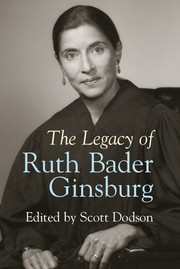12 - The Once and Future Federalist
Published online by Cambridge University Press: 05 February 2015
Summary
Our Constitution established a federal system that embraces both autonomous states and a strong national government. Preserving that constitutional scheme has challenged the Supreme Court since its earliest days. As Chief Justice John Roberts recently recognized, “the path of” the Court’s federalism jurisprudence “has not always run smooth.” That path has been particularly jagged during recent years. In a series of high-profile cases, the Court has undercut both national authority and state autonomy; the results defy both the Constitution and any principled view of federalism.
Justice Ruth Bader Ginsburg has repeatedly dissented from these decisions, articulating a coherent view of federalism that honors both national power and state autonomy. Justice Ginsburg’s opinions draw upon federalism principles that the Court forged during the middle decades of the twentieth century; this is the federalism that prevailed before the muddled federalism “revolution” of the Rehnquist and Roberts Courts.
Justice Ginsburg, however, has rei ned those twentieth-century doctrines, giving them a voice of her own. As the Court’s most persistent and articulate dissenter in federalism cases, she has crafted a nuanced vision of federal-state relations that serves the Constitution, national interests, and the continued vitality of state governments.
This chapter explores several of Justice Ginsburg’s most notable federalism opinions. Part one examines representative cases in which Justice Ginsburg recognized Congress’s power to legislate in the national interest.
- Type
- Chapter
- Information
- The Legacy of Ruth Bader Ginsburg , pp. 172 - 196Publisher: Cambridge University PressPrint publication year: 2015



